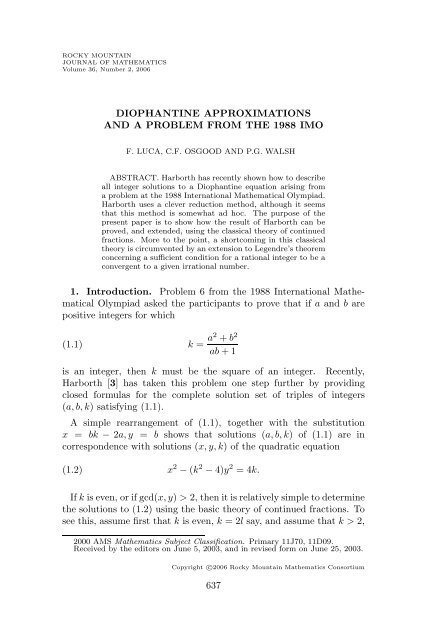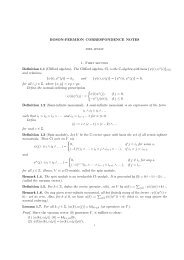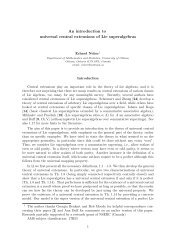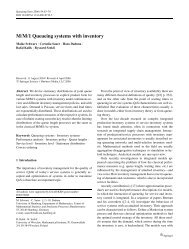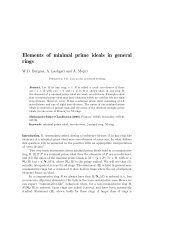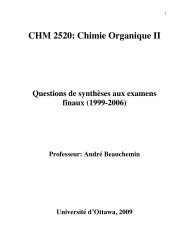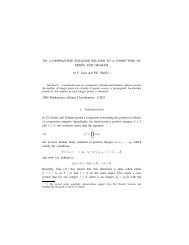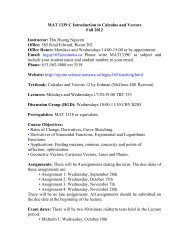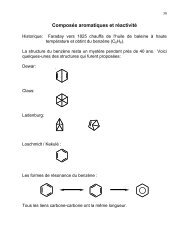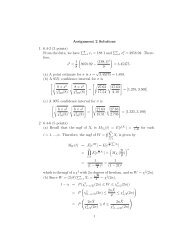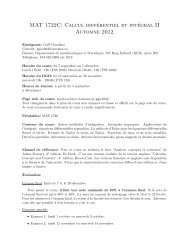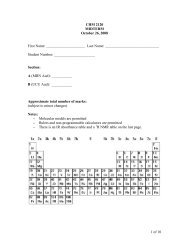DIOPHANTINE APPROXIMATIONS AND A PROBLEM FROM THE ...
DIOPHANTINE APPROXIMATIONS AND A PROBLEM FROM THE ...
DIOPHANTINE APPROXIMATIONS AND A PROBLEM FROM THE ...
You also want an ePaper? Increase the reach of your titles
YUMPU automatically turns print PDFs into web optimized ePapers that Google loves.
ROCKY MOUNTAINJOURNAL OF MA<strong>THE</strong>MATICSVolume 36, Number 2, 2006<strong>DIOPHANTINE</strong> <strong>APPROXIMATIONS</strong><strong>AND</strong> A <strong>PROBLEM</strong> <strong>FROM</strong> <strong>THE</strong> 1988 IMOF. LUCA, C.F. OSGOOD <strong>AND</strong> P.G. WALSHABSTRACT. Harborth has recently shown how to describeall integer solutions to a Diophantine equation arising froma problem at the 1988 International Mathematical Olympiad.Harborth uses a clever reduction method, although it seemsthat this method is somewhat ad hoc. The purpose of thepresent paper is to show how the result of Harborth can beproved, and extended, using the classical theory of continuedfractions. More to the point, a shortcoming in this classicaltheory is circumvented by an extension to Legendre’s theoremconcerning a sufficient condition for a rational integer to be aconvergent to a given irrational number.1. Introduction. Problem 6 from the 1988 International MathematicalOlympiad asked the participants to prove that if a and b arepositive integers for which(1.1) k = a2 + b 2ab +1is an integer, then k must be the square of an integer. Recently,Harborth [3] has taken this problem one step further by providingclosed formulas for the complete solution set of triples of integers(a, b, k) satisfying (1.1).A simple rearrangement of (1.1), together with the substitutionx = bk − 2a, y = b shows that solutions (a, b, k) of (1.1) are incorrespondence with solutions (x, y, k) of the quadratic equation(1.2) x 2 − (k 2 − 4)y 2 =4k.If k is even, or if gcd(x, y) > 2, then it is relatively simple to determinethe solutions to (1.2) using the basic theory of continued fractions. Tosee this, assume first that k is even, k =2l say, and assume that k>2,2000 AMS Mathematics Subject Classification. Primary 11J70, 11D09.Received by the editors on June 5, 2003, and in revised form on June 25, 2003.Copyrightc○2006 Rocky Mountain Mathematics Consortium637
<strong>DIOPHANTINE</strong> <strong>APPROXIMATIONS</strong> <strong>AND</strong> A <strong>PROBLEM</strong> 639of the solution set of equation (1.1). What seems most interesting isthat this method, which is designed to solve (1.1), provides a way tocompletely solve equation (1.2). We will be terse for the sake of brevity.Theorem 2.1. All positive integers (a, b, k), witha ≤ b, forwhichk =(a 2 + b 2 )/(ab +1) is an integer are given by1. k odd. (a, b, k) =(ly, (lx + l 3 y)/2,l 2 ),where(x, y) satisfy x 2 −(l 4 − 4)y 2 =4.2. k even. (a, b, k) = (ly, lx +(l 3 /2)y, l 2 ), where (x, y) satisfyx 2 − (4l 4 − 1)y 2 =1.The main idea of the proof of Theorem 2.1 is given in the followingresult.Lemma 2.1. Let a 3, forcing m =3,andthefraction in (2.1) to be 1.We have shown that k = m +1,andthata 2 + mar + r 2 − m = ma 2 + ra +1.Substituting a − s for r in this last equation, and some rearrangingyieldsa 2 + s 2 =(m +1)(as +1),
640 F. LUCA, C.F. OSGOOD <strong>AND</strong> P.G. WALSHwhich proves the only if portion of the theorem. For the converse, if(a, s, m + 1) is a solution to (1.1), then putting b = ma +(a − s), onecan see that (a, b, k) is also a solution.Theorem 2.1 is now a simple consequence of this lemma and theremarks in the Introduction. First of all, it is clear that all of thesolutions given in the statement of Theorem 2.1 satisfy (1.1). To showthat all solutions of (1.1) are of the described form, let (a, b, k) beasolution of (1.1). If gcd(a, b) > 2, then one obtains a solution (x, y)to (1.2) with gcd(x, y) > 2. The remarks given in the Introductionshow how such a solution must be an integer multiple of a unit ineither Z[ √ l 2 − 1], where k =2l, orZ[(1 + √ k 2 − 4)/2] in the case thatk is odd. By considering the two cases of the parity of k separately,one is led to a solution of the form described in the statement of thetheorem. If gcd(a, b) = 2, then there exists a solution to (1.2) withgcd(x, y) =2. Ifk is odd, then as described in the previous section,this leads to a solution (x, y) to (1.2) with gcd(x, y) = 1, and hencetoasolution(a, b) of (1.1) with gcd(a, b) = 1, and this will be dealtwith henceforth. If (x, y) is a solution to (1.2) with gcd(x, y) =2and√k =2l, then 4 divides x. It follows that (x/4)/(y/2) is a convergent tol2 − 1, and the argument proceeds as in the previous cases. Finally,if (a, b, k) is a solution to (1.1) with gcd(a, b) =1andb>a,thenin the notation of Lemma 2.1, (a, s, k) is also a solution and satisfiesa>s>0, gcd(a, s) = 1. Repeating this reduction procedure musteventually lead to a solution (s 1 , 1,k), where s 1 > 1, contradicting thefact that (a, b, k) =(1, 1, 1) is the only solution to (1.1) with one of aor b equal to 1.We see then that the method of Harborth not only determines allsolutions to (1.1), but also provides a clever, but somewhat ad hoc,approach for solving equation (1.2). We state this as a corollary toTheorem 2.1.Corollary 2.1.equationIf k > 1 is an odd integer, then the quadraticx 2 − (k 2 − 4)y 2 =4khas no solutions in coprime integers (x, y).
<strong>DIOPHANTINE</strong> <strong>APPROXIMATIONS</strong> <strong>AND</strong> A <strong>PROBLEM</strong> 641As mentioned before, it is very surprising that this result canbe proved using the reduction techniques described in the proof ofLemma 2.1 and yet does not follow directly from known results in thetheory of diophantine approximation, in particular, from Legendre’snecessary condition for an approximation to be a convergent. The nextsection is an attempt to remedy this situation.3. Diophantine approximations. Throughout this discussion, αwill denote an irrational number. Legendre proved that if a rationalnumber p/q satisfies |α − p/q| < 1/(2q 2 ), then p/q is a convergent to α.As we have seen above, this result is not strong enough to show that(1.2) is not solvable in coprime integers x and y. Inthissectionwedescribe necessary conditions when a given approximation is not quitegood enough to be concluded a convergent.Throughout the paper we will make reference to the usual notationconcerning the continued fraction expansion of an irrational number.In particular, ifα = a 0 +1a 1 + 1a 2 +...for an integer a 0 and positive integers a 1 ,a 2 ,..., then this is the continuedfraction expansion of α, denoted neatly by α =[a 0 ; a 1 ,a 2 ...],each a n is a partial quotient,andtheconvergents to α are given byp nq n=[a 0 ; a 1 ,a 2 ... ,a n ], (p n ,q n )=1.The numerators and denominators of convergents satisfy the recursionformulaep n+1 = a n+1 p n + p n−1 ,q n+1 = a n+1 q n + q n−1 for n ≥ 1.We will use the fact that, for each n ≥ 0, the inequality(3.1)∣ α − p ∣n ∣∣∣ 1
642 F. LUCA, C.F. OSGOOD <strong>AND</strong> P.G. WALSHDefinition. Assume that α has the continued fraction expansiongiven above. A mediating fraction to α is any rational number p/q ofthe formp = mp n + p n−1 ,q= mq n + q n−1 ,where 1 ≤ m ≤ a n+1 .Notice that a convergent is the special case of a mediating fraction,namely when m = a n+1 .Theorem 3.1. Let α denote an irrational number and r/s arationalnumber in reduced form, with s ≥ max(2,q 1 ), such that(3.2)∣ α − r s ∣ < 2 s 2 .Then there exist integers n ≥ 1 and 1 ≤ m 1 s 2 ,and if (r, s) satisfies condition (iv), butnot(i), (ii), or(iii), then∣ α − r s∣ > 32s 2 .Remark. Inthecasethats
<strong>DIOPHANTINE</strong> <strong>APPROXIMATIONS</strong> <strong>AND</strong> A <strong>PROBLEM</strong> 643Proof. By replacing α by α − a 0 , there is no loss in generality inassuming that 0 < α < 1. Given r/s, let n ≥ 1 be defined byq n ≤ s α, since the alternativecase can be treated in a similar manner. We use the fact that( ) (r(3.3) rq n − sp n = sq ns − α + sq n α − p )n.q nIf s = q n , then (3.1) and (3.2) show thatq n |r − p n | = |rq n − sp n | α.{p n−1pn
644 F. LUCA, C.F. OSGOOD <strong>AND</strong> P.G. WALSHis negative, but of absolute value smaller than s/q n+1 < 1, it followsthat rq n − sp n is nonnegative. Moreover, since 2q n /s < 2, we see that(3.5) rq n − sp n =1.Therefore 1 < 2q n /s, which also implies that sα, it follows that (p n /q n ) > (p n−1 /q n−1 ), and hence(3.6) p n−1 q n − q n−1 p n = −1.It is well known that, if a and b are coprime and x 0 and y 0 is an integersolution of ax − by = 1, then all the solutions of ax − by =1areofthe form x = x 0 + mb and y = y 0 + ma for some integer m. Fromthisremark, together with (3.5) and (3.6), there is an integer m for whichr = −p n−1 + mp n and s = −q n−1 + mq n .Sinceq n
<strong>DIOPHANTINE</strong> <strong>APPROXIMATIONS</strong> <strong>AND</strong> A <strong>PROBLEM</strong> 645If(3.9)( ) rs − α < 1 s 2 ,then0
646 F. LUCA, C.F. OSGOOD <strong>AND</strong> P.G. WALSHProof. Let α =(1+ √ k 2 − 4)/2. As x and y are odd, (4.1) can berewritten as(((x+y)/2y−1+ √ )) ((k 2 − 4 (x+y)/2−2y1 − √ ))k 2 − 4= t2y 2 .If ((x + y)/2)/y < (1 + √ k 2 − 4)/2, the product is negative, contradictingthe fact that t is positive. Therefore, we must have that((x + y)/2)/y > (1 + √ k 2 − 4)/2. From our assumption on t, wehavethat((x + y)/2 1+ √ )k−2 − 4y2t=y 2 (((x + y)/2)/(y) − ((1 − √ k 2 − 4)/2))t
<strong>DIOPHANTINE</strong> <strong>APPROXIMATIONS</strong> <strong>AND</strong> A <strong>PROBLEM</strong> 647for i ≥ 0 and even, andx 2 − y 2 (k 2 − 4) = 4for i ≥ 0 and odd.Consider first the case that ((x + y)/2)/y is a mediating fraction.In the 0th step, the mediating fractions are simply i/1 with1≤ i ≤(k − 1)/2. Putting (x, y) =(2i − 1, 1), we see that these mediatingfractions lead to x, y for which x 2 − y 2 (k 2 − 4) is negative.For 1 ≤ i ≤ (k−1)/2, put δ i = ((2i − 1) + √ k 2 − 4)/2. Consider nowthe case that (x, y) =(2u − v, v) whereu/v is a mediating fraction inthe 2nth iteration of the continued fraction (recall that a 2n−1 =1forall n ≥ 1, and so we need only consider the even-indexed iterations).Defineε = k + √ k 2 − 4;2then it can be seen that for some i =1,... ,(k −1)/2, and some integerj,x + y √ k 2 − 4= δ i ε j ,2from which it follows that x 2 − y 2 (k 2 − 4) is negative. Thus, mediatingfractions lead only to values x, y for which x 2 − y 2 (k 2 − 4) is negative.Now consider the case that there are consecutive convergents p n−1 /q n−1 , p n−2 /q n−2 to α for which(4.2)(x + y)/2y= p n−1 +2p n−2q n−1 +2q n−2,and a n = 1. It follows that n must be odd. In the case n =1,weseethat ((x + y)/2)/y =((k +3)/2)/1. Therefore, y =1,x = k +2andx 2 − y 2 (k 2 − 4) = 4(k +2). Letγ 1 =((k +2)+ √ k 2 − 4)/2, and forn>1andn odd, let γ n =(x + y √ k 2 − 4)/2, where x and y satisfy(4.2). Then, as in the previous case,γ n = γ 1 ε jfor some integer j, andsox 2 − y 2 (k 2 − 4) = 4(k +2).
648 F. LUCA, C.F. OSGOOD <strong>AND</strong> P.G. WALSHIn the case that there are consecutive convergents p n−1 /q n−1 ,p n−2 /q n−2 to α for which((x + y)/2)/y =(2p n−1 − p n−2 )/(2q n−1 − q n−2 ),a similar analysis shows that either x 2 − y 2 (k 2 − 4) = 4(k +2) orx 2 − y 2 (k 2 − 4) = −6k + 13. This completes the proof of the theorem.Note added in proof. Worley [8] has proved results very similar toTheorem 3.1. We thank Andrej Dujella for making us aware of Worley’swork.Acknowledgments. The authors gratefully acknowledge the commentsof the anonymous referee. The third author is grateful to theNatural Sciences and Engineering Research Council of Canada for itssupport.REFERENCES1. P. Fatou, Sur l’approximation des incommensurables et des séries trigonométriques,C.R. Acad. Sci. Paris 139 (1904), 1019 1021.2. J.H. Grace, The classification of rational approximations, Proc. London Math.Soc. 17 (1918), 247 258.3. H. Harborth, Positive integers (a 2 + b 2 )/(ab +1) are squares, preprint, 2002.4. A. Hurwitz, Über die angenäherte Darstellungen der Zahlen durch rationaleBrüche, Math. Ann. 44 (1894), 417 436.5. Y.A. Khinchin, Continued fractions, Univ. of Chicago Press, Chicago, 1964.6. W.M. Schmidt, Diophantine approximation, Lecture Notes in Math. 785,Springer-Verlag, New York, 1980.7. C.-O. Selenius, Kriterion für Zahlen quadratischer Zahlkörper mit Normbetragkleiner als die Quadratwurzel aus der Diskriminante, Acta Acad. Abo. 26, 1966.8. R.T. Worley, Estimating |α − p/q|, J. Austral. Math. Soc. 31 (1981), 202 206.Instituto de Matemáticas UNAM, Campus Morelia Ap. Postal 61-3(Xangari)CP 58 089, Morelia, Michoacán, MexicoE-mail address: fluca@matmor.unam.mxNSA Mathematical Sciences, National Security Agency, Suite 6557,Ft. George G. Meade, MD 20755-6557Department of Mathematics, University of Ottawa, 585 King EdwardSt., Ottawa, Ontario, Canada K1N-6N5E-mail address: gwalsh@mathstat.uottawa.ca


